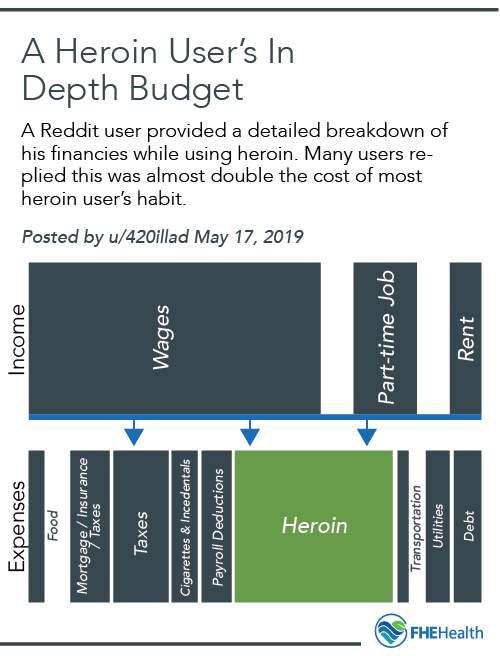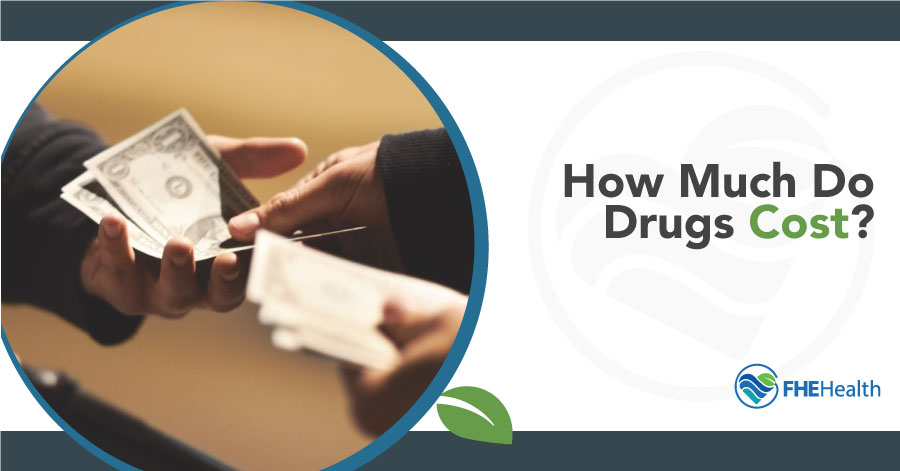
Many factors affect the prices of illicit drugs, making it difficult to provide exact prices for them. The price can even vary regionally because they’re affected by supply and demand just like other goods.
The economic conditions in a given area also matter. Drugs may cost more in an affluent area simply because the residents can afford to pay more for them. The cheapest drugs are usually ones that are easy to obtain (such as marijuana) and are sold in low-income areas.
Another important factor is the difficulty of obtaining a substance. Dangerous drugs are harder to find, and this makes the price higher. Those who are addicted to a highly controlled substance are often willing to pay high prices, even though they can’t be sure that what they’re buying is that drug.
In the following sections, we give some examples of recent street prices for common drugs. Keep in mind prices can change quickly and vary between cities, so these prices are simply historical examples.
The Impact of Addiction: Users Explain Their Drug-Related Spending
While looking at the individual hit price is important, it’s also essential to consider how much a person is spending on drugs in comparison to their overall income. It’s difficult to get a true picture of how much the average drug user spends because this isn’t something most people are willing to share freely.
Anonymous users talked about their spending habits and strategies for affording drugs in a Reddit thread. They wanted to show just how much they spend each month and how they were able to afford their habit even on modest incomes. For example, one user explained that they’d buy extra of their drug of choice to benefit from bulk discounts and sell some of that extra at the undiscounted price to fund their drug use.
Others talked about how they turned to theft to fund their $150/day habits. One poster called addiction a “full-time job,” and a
How Does the Government Price Drugs?
How does law enforcement place a price tag on the street drugs they seize? Government agencies use a variety of factors to determine street drug prices and estimate what people at all levels are paying for them. Local, state, and county authorities generally use their own data based on what it costs to buy those drugs within their communities.
The federal government uses data based on many factors, including insight from agents working in the field. They also gather information about drug prices when they seize both the drugs and the money used to pay for them.
The U.S. Drug Enforcement Administration does this at the federal level. The agency works through the Office of National Drug Control Policy to police, research,h and distribute information related to the cost of drugs. At all levels, each field office may use a different price point, so the average citizen may have difficulty getting access to the report that lists the costs of any given drug.
Law enforcement has an easier time determining the cost of high-value drugs, such as cocaine and heroin, because it can gather data based on drug busts and seizures to make those estimates.
Unfortunately, there’s no publicly available street drug price chart published by law enforcement agencies. Some internal documents include guidelines, but without access to the data possessed by law enforcement agencies, those documents aren’t easy for members of the public to understand.
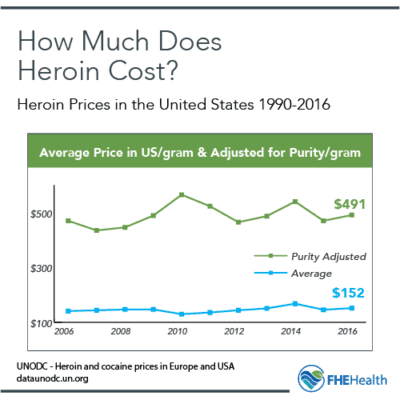 How Much Does Heroin Cost?
How Much Does Heroin Cost?
The price of heroin appears to have fallen in recent years. The United Nations Office on Drugs and Crime provides a detailed estimated cost of heroin, as well as other drugs. Back in 2016, the average cost of a small baggie of heroin was up to $20. It could be sold for as little as $5 in some areas. The average price of the drug was $152 per gram, based on U.S. data. A dealer generally divides a gram into about 20 bags.
Heroin is far easier to get hold of today, and prices have fallen as a result. However, heroin’s makeup changes frequently. The more powerful the drug combinations are, the more expensive they become. Some dealers are cutting heroin, along with black tar heroin, with other products significantly to increase prices.
According to some recent purchase data on StreetRx, 1 gram of heroin cut with fentanyl was available for $60 in Muncie, Indiana, while 1 gram of black tar heroin cost just $25 in Dallas, Texas. Basic, uncut heroin is relatively hard to find, but the relatively low costs of other forms of heroin have made it accessible to a wider range of people.
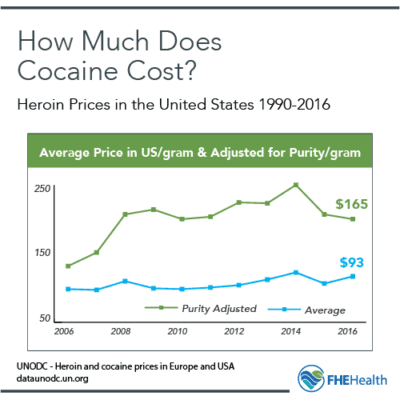 How Much Does Cocaine Cost?
How Much Does Cocaine Cost?
Cocaine is one of the most expensive street drugs. This is because importing cocaine into the United States has become more challenging in recent years. Port authorities are more suspicious of packages and have increased both random and all-product screenings at the borders.
In terms of quality, cocaine is generally weakened when sold. Dealers often add powder or other substances to it to stretch their supply. This allows the dealer to walk away with more money in their pocket, but the quality of the cocaine they’re selling is much lower. Cocaine users with a serious addiction may need to spend more to purchase enough cocaine to meet their needs.
According to the United Nations Office on Drugs and Crime, the street purity of cocaine in Costa Rica is somewhere between 0.79 and 0.89, meaning as much as 21% by weight of the cocaine sold on the streets is not cocaine.
The average cost of cocaine in 2019, the most recent year for which data is available, is $120 per gram, around a 30% increase on the 2016 prices from the previously mentioned UNODC report. It’s likely that 2024 prices will be even higher, given the difficulty of bringing cocaine into the United States.
For those who have a severe cocaine addiction, it can be an expensive habit. It’s not uncommon for people to need as much as 5 grams per day to sustain a significant habit, which can amount to thousands of dollars each month.
How Much Is Crack Cocaine?
Because cocaine has become so expensive and hard to find, many people seek out crack or crack cocaine instead. Because it’s in a crystalized format, it doesn’t have the same amount of the drug as a gram of cocaine. A person purchasing crack will spend much less because the substance is less pure and more accessible.
It’s hard to pinpoint the drug street price for crack cocaine because prices range widely based on location. The USDOC report gives prices of around $90 per gram in 2019, and more recent anecdotal reports suggest prices of $90-$100 are still current, depending on location. Usually, a person purchasing it would buy a gram at a time. Those with a serious addiction to crack, though, could spend $250 or more per day to fuel their addiction.
How Much Does Marijuana Cost?
Marijuana is one of the most complex drugs to put a price tag on. In some areas, it’s now legal for recreational use. In others, it’s legal for medical use. These laws have helped make the drug more accessible. Because it’s inexpensive to grow, especially in areas where it’s legalized, and easy to transport, marijuana’s pricing ranges widely.
Another key reason the costs range so much is the potency. Recreational and medical cannabis users can choose from numerous strains, each bred to have different levels of THC and CBD in them.
Some users have strong preferences for mild varieties that may help the symptoms of their medical conditions without impacting their ability to perform day-to-day tasks. In contrast, recreational users may seek out strains that produce a stronger high.
The price of marijuana varies dramatically depending on the drug’s legal status. For example, in Los Angeles, where cannabis has been legal for recreational use for a long time, marijuana can be purchased for $2.60 per gram. The drug is also less than $5 per gram in Detroit and Maryland.
In Hawaii and Louisiana, where recreational use of marijuana is forbidden, prices are much higher. For example, in Honolulu, buyers can expect to pay $25 per gram, while in New Orleans, prices for good quality cannabis can be as much as $100 per gram.
Of course, the legal status of the drug isn’t the only factor that impacts the price. The relative affluence of the area and the type of marijuana being sold make a big difference. Some cannabis users add other herbs to their joints to make the cannabis they buy go further. Others use lower-grade/less expensive cannabis and add kief or resin to increase the level of THC.
Let’s not forget that smoking marijuana isn’t the only way to imbibe THC. Some users prefer edibles or vape oils that contain THC instead of smoking it in leaf form.
The cost of a cannabis habit varies depending on how often it’s consumed and the quality. One ounce of weed is enough to make about 42 joints or 28 blunts. Some people use it infrequently; others smoke four or more joints per day. Depending on the location and other factors, this can amount to spending $500 or more per month on the drug.
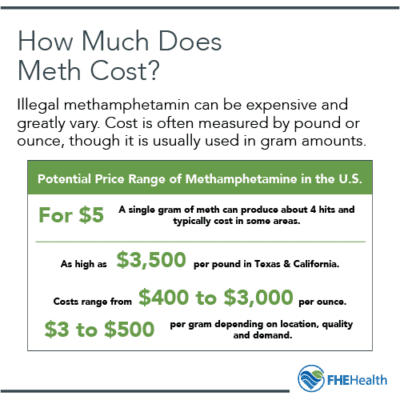 How Much Does Meth Cost?
How Much Does Meth Cost?
Meth, or methamphetamine, can be an expensive drug. Prices can range from as low as $10 per gram up to $400 per gram, depending on the purity of the drug and the location it’s being sold in.
A single gram of meth can produce about four hits, and in areas where meth is readily available, a hit costs about $5. In rural areas, meth is often thought of as an inexpensive drug to get a big high from. Because of this, the drug has a relatively high overdose rate.
People who become addicted to methamphetamine may find themselves taking large quantities of the drug and spending in excess of $1,000 per month on their addiction. In areas where meth prices are comparatively high, spending can be 2 or 3 times that figure.
What About Prescription Pill Illicit Use?
The street price for the illicit use of prescription medications ranges significantly based on the drug of choice, location, and availability. Many drugs are sold by the pill, especially those that are more in demand such as Vicodin.
Many factors can play a role in cost. For example, if someone wishes to purchase the name-brand Vicodin, they’ll pay more for it than for an off-brand product. Purchasing a bottle can be more expensive than purchasing a set of pills.
As an example of this, a single Vicodin pill costs $20 in Florida, according to StreetRx. Generic versions cost as little as $1 in Washington and up to $15 in Chicago, Illinois.
Illicitly sold prescription drugs are readily accessible in most areas of the country. However, as opioid prescriptions become more difficult to obtain, prices for such drugs are rising. That’s why many people look for alternatives, such as heroin or fentanyl.
Take a look at the street cost of some of the most common prescription opioids and other illicit drugs sold illegally in the United States:
- A single 2-milligram pill of Xanax costs between $5 and $12, depending on location.
- A single Adderall costs between $2 and $45, depending on dose and location.
- A single OxyContin pill of 20 milligrams costs $20.
- A 10-milligram methadone tablet, off-brand, costs $10.
- A single Viagra pill of 100 milligrams costs between $10 and $20, depending on location.
- A single Suboxone film of 8 milligrams is about $20.
- A fentanyl patch, which is about 25 micrograms, is about $40.
The key here is that these prices are always changing, often daily. They also vary significantly from one area of the country to another. StreetRx provides some up-to-date and real-time costs associated with the street price of these drugs across the country.
All prices in this street drug price guide are subject to change due to location, demand, and availability. In addition, prices are user-submitted and aren’t reviewed for accuracy, so this information should be used for general guidance only. It can be difficult to pinpoint prices in any area, including for illicitly sold prescription drugs, but they most certainly are more expensive than purchasing a prescription from a pharmacy.
The Hidden Cost of Addiction
Substance addiction involves more expenses than simply the cost of the substance in question. The hidden cost of drug and alcohol addiction doesn’t remain hidden for long. Substance addiction will eventually negatively impact a person’s physical and mental health. When alcohol and drugs do begin to impact a person’s health and overall well-being, the costs can accumulate rapidly.
Substance addiction is associated with a dizzying array of health complications. They range from mental illness to physical health conditions, such as the development of some cancers, organ damage, and cardiovascular disease. The cost to deal with these health issues can quickly escalate. The need for ongoing treatments and medication further adds to the expense of addiction.
Aside from health complications, individuals with a substance addiction often experience job loss or lost wages from work. When a person becomes ill with a long-term or chronic health condition, they may be unable to work and earn wages. The costs needed to maintain your home, transportation, food, and other needs become challenging or impossible depending on your condition.
A person who’s no longer able to hold down a job due to addiction may start looking for the cheapest drug options that will feed their addiction. This brings with it additional risks if the drugs they’re buying aren’t pure or aren’t actually what they think they’re purchasing.
Costs vary depending on a person’s health and other circumstances. Some people may face legal expenses associated with their drug or alcohol use. Others may experience divorce or other expensive problems related to their substance addiction. The cost in terms of damage to a person’s reputation and relationships can be harder to recover from than the financial cost.
Cost of Addiction Treatment
We’ve certainly demonstrated how expensive substance addiction is, but there are more costs to consider. The cost of rehab can be a barrier to getting treatment. This is unfortunate because treatment saves lives and prevents further escalation of costs related to drug addiction.
Nevertheless, addiction treatment is an investment in your future. It can prevent drugs and alcohol from further eroding health, and it helps people get their lives and finances back on track. People who have an addiction but are still working and have benefits should take advantage of their medical insurance now while their job is secure. It’s not uncommon for drug addiction to eventually impact your job, making job loss more than a remote possibility.
Getting treatment now is the best means to protect your job. Mental health and substance abuse treatment are covered by most insurance plans, and employers can’t discriminate against any employee seeking behavioral health or other healthcare treatments. Some people may be able to complete a drug addiction treatment program in 30 days; others may require much longer. Today, people have lots of options for treatment, including inpatient and outpatient rehab programs. Both can be costly, but again, these programs help clients put substance addiction behind them.
People who lose their employment may still be eligible for free resources and may qualify for Medicaid, but the process of claiming these benefits can be challenging; the quality of care may vary, and each person’s circumstances may impact whether they qualify for this type of assistance.
Getting in touch with a rehab facility or healthcare provider is the best way to begin the treatment process. They can advise patients about their plan and its coverage options or recommend resources that will help them on their treatment and recovery journey.
Are You Tired of Spending So Much on Drugs?
For those who are ready to stop their habit, it’s critical to seek help. At FHE Health, a compassionate counselor is available to speak to you 24 hours a day. Contact FHE Health today to get started on your recovery journey.
